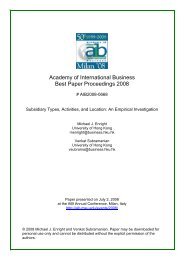AIB 2012 Conference Proceedings - Academy of International ...
AIB 2012 Conference Proceedings - Academy of International ...
AIB 2012 Conference Proceedings - Academy of International ...
Create successful ePaper yourself
Turn your PDF publications into a flip-book with our unique Google optimized e-Paper software.
MONDAY<br />
Entrepreneurship, Competitiveness and Economic Growth <strong>of</strong> BRICS Countries: An Empirical Analysis <strong>of</strong> Data<br />
From GEM and GCI<br />
Raimundo Eduardo Silveira Fontenele, Universidade de Fortaleza<br />
Paulo Francisco Barbosa Sousa, Universidade Federal do Ceara<br />
Alexandre Oliveira Lima, Universidade de Fortaleza<br />
Entrepreneurship can help economic growth in some countries by the introduction <strong>of</strong> new products on the<br />
market or by the evolution <strong>of</strong> existing products, as much as by changes in the production process and increases<br />
in market competition. This study investigates the influence <strong>of</strong> per capita income, health care and primary<br />
education, higher education and training, and technology and sophistication <strong>of</strong> businesses, in the differences in<br />
the total rate <strong>of</strong> entrepreneurship among BRICS countries, which refers to Brazil, Russia, India, China and South<br />
Africa. The survey was conducted with a multivariable statistical analysis. The regression was obtained in two<br />
models, <strong>of</strong> which the first used the overall value <strong>of</strong> the CGI (overall index) as a proxy for competitiveness, while<br />
the second model used the twelve indicators that make up the GCI each separately. The results reinforce the<br />
hypothesis that there is a positive relationship between the indices <strong>of</strong> competitiveness and the rate <strong>of</strong><br />
entrepreneurship. (For more information, please contact: Raimundo Eduardo Silveira Fontenele, Universidade de<br />
Fortaleza, Brazil: fontenele@unifor.br)<br />
Session: 2.1.12 - Interactive<br />
Track: 12 - Value Creation and Work<br />
The Geography <strong>of</strong> Value Creation: Clusters, Networks, Ethnic Ties<br />
Presented On: July 2, <strong>2012</strong> - 09:00-10:15<br />
Chair: Gabriele Suder, SKEMA Business School and ANUCES Fellow<br />
<strong>International</strong> Input-Output Dynamics as a Measure <strong>of</strong> the Geography <strong>of</strong> Value-Distribution Across Asia and <strong>of</strong><br />
Market Integration<br />
Gabriele Suder, SKEMA Business School and ANUCES Fellow<br />
Satoshi Inomata , JTRO- IDE<br />
Irina Jormanainen, Aalto School <strong>of</strong> Economics<br />
Bo Meng, JETRO- IDE<br />
Regional integration, the interdependence in regional trade and production networks, has important implications<br />
for economic development and the location <strong>of</strong> international business activity. This paper adopts a novel<br />
approach to analyze the evolution <strong>of</strong> such production networks in Asia over time. We study its impact on the<br />
location <strong>of</strong> production hubs, indicating a high density <strong>of</strong> cross-border interaction and geographic dynamics as<br />
part <strong>of</strong> the interrelation <strong>of</strong> value addition and geographical location <strong>of</strong> cross-border production activity. We<br />
undertake a longitudinal study using empirical evidence about the period 1985-2000 and analyze interlinkages<br />
and underlying factors affecting the change in the geographic distribution <strong>of</strong> network hubs, with an emphasis on<br />
Country-specific advantages (CSAs). Our empirical methodology is based on the analysis <strong>of</strong> Input-Output data<br />
for nine Asian countries in three <strong>of</strong> the most integrated sectors <strong>of</strong> the manufacturing industry. We calculate<br />
their coefficient <strong>of</strong> variation and mapping, and assess countries' gain and give-out potential <strong>of</strong> value in the<br />
production process. We support our results with an assessment <strong>of</strong> inward and outward investment flow<br />
locations and the convergence <strong>of</strong> locations <strong>of</strong> production network hubs and FDI. The findings demonstrate that<br />
the distribution <strong>of</strong> production hubs changes significantly over time; the emergence <strong>of</strong> Asian economies is<br />
embedded in overall regional integration. Value-added hubs center on and evolved around China and Japan.<br />
This is confirmed by the evolution <strong>of</strong> FDI locations. We argue that changes in country-specific advantages and<br />
specialization in Asian countries explain this result <strong>of</strong> rapid internal regional development and the need to<br />
respond to the pressures <strong>of</strong> the global business environment. (For more information, please contact: Gabriele<br />
Suder, SKEMA Business School and ANUCES Fellow, France: gabriele.suder@skema.edu)<br />
<strong>AIB</strong> <strong>2012</strong> <strong>Conference</strong> <strong>Proceedings</strong><br />
Page 115

















